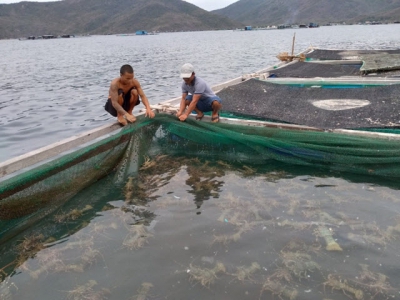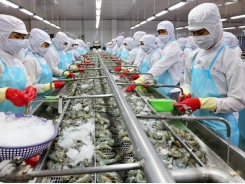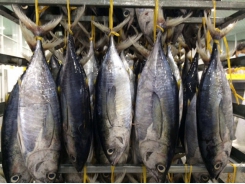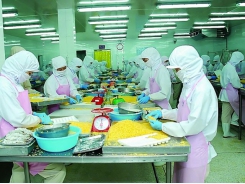Proactive prevention against epidemic diseases in lobsters farming

In recent years, epidemic diseases on lobster raised in Khanh Hoa Province have tended to decrease due to the preventive measures taken proactively by farmers.
Epidemic diseases on lobsters grown in Khanh Hoa have recently decreased. Photo: KS.
Rate of epidemic diseases on lobsters decreases
Cam Binh Commune, Cam Ranh City - is considered as the "capital" of blue lobster farming in Khanh Hoa Province, with an aquaculture area of nearly 90 hectares, 469 floating rafts, and nearly 10,000 cages. In the past time, lobster farming in cages in this commune has brought high income to the households, contributing to the socio-economic development of the locality.
Mr. Lam Anh Tuan, Chairman of Cam Binh Commune Farmers' Association, said that to sustainably develop lobster growing, the locality has warned of two main issues for farmers in recent years. The first is to protect the farming environment. For this issue, the association has over the years developed a plan and guided the implementation for each member through its local branches, in order to raise their awareness and in handling shrimp leftovers, limiting the use of plastic bags by changing to the use of mesh bags to protect the marine environment.
Secondly is to proactively prevent and control diseases on farmed shrimp such as the red body, black gills, white antenna, long head, white spots on shells, and other environmental-related diseases. As a result, the disease situation in shrimp farming has changed dramatically in recent years with the rate of infection only accounting for 5-10% of the cages.
Mr. Le Van Hoa, a lobster farmer in Binh Ba Dong village, Cam Binh Commune confirmed that the epidemic disease situation in shrimp growing, especially those called milk and black gill diseases, has been very rare in recent years, while before, it used to cause vast losses of up to 30-40% for productivity. According to Mr. Hoa, to reduce the loss rate, people must comply with the recommended measures that local authorities and specializing agencies had recommended in disease prevention and control.
Specifically, the selection of breeds and healthy rearing with a medium density of about 300-400 shrimps/cage, periodic supplementation of probiotics, vitamins, and minerals have been concerned so that to strengthen the resistance of farmed shrimp and to avoid pathogens… Thanks to that, farming has been effective. Mr. Hoa's family, for example, owns 30 cages of lobsters grown according to a rolling-mat style. In recent years, shrimp farming is quite effective with a low loss rate and annual profit reaching about VND300 million. This year alone, as the price of lobster stands at a high level, his family recently earned a profit of nearly VND500 million.
Similarly, in the main farming areas of star lobster (cotton shrimp) in Van Thanh Commune (Van Ninh District), milk and black gill diseases on farmed shrimp have also decreased in recent years, only occurring sporadically.
Mr. Vo Tan Phong, Chairman of Van Thanh Commune Farmers' Association, said such good results were due to an increase of awareness among farmers in proactively preventing and controlling shrimp diseases. Farmers now grow shrimp in a moderate density of only 70-80 heads/cage, different from the past when they released about 100 heads/cage. Besides, people pay more attention to caring for the shrimps, periodically supplementing them with vitamins and minerals to increase their resistance against diseases.
According to Ms. Tran Thanh Thuy, Deputy Director of Khanh Hoa Animal Husbandry and Veterinary Sub-Department, based on the results of monitoring and proactively guiding disease prevention for lobsters farmed in the area over the past time, it shows that the situation has achieved many positive changes.
In 2018, the whole province reported about 10,517 lobster cages with scattered deaths (from 1-2 heads/cage) due to milk and red body diseases. However, in 2019, the whole province found only 63 cages with signs of shrimp death due to milk and black gill diseases and in 2020 only 40 cages found infected with milk disease detected in Nha Trang. Especially, in the first nine months of 2021, lobster farming areas in all localities have not detected any epidemic.
Recommendation
According to Ms. Thuy, among the common diseases on farmed lobsters, those that cause damage and loss in quantity are milk and red body disease. For those areas with high sediment, black gill disease is also causing relatively big losses to farmers.
Therefore, to help farmers actively prevent and control diseases every year, the Sub-Department is carrying out propaganda, training, and monitoring of disease outbreaks in farming areas (both active and passive monitoring). From then on, it is guiding farmers to take synthetic measures in disease prevention such as selecting breeds, rearing, thinning the raising density, taking care and managing aquatic products, etc. Besides, the Sub-Department also uses the periodical data on environmental and disease monitoring provided by the Aquaculture Research Institute III and Sub-Department of Fisheries to make a bulletin to inform farmers so that they can proactively handle the occurrences.
However, Ms. Thuy noted that when diseases occurred or there were signs of a large death, farmers need to consider three basic factors: shrimp health, environmental condition, and prediction of pathogens. (symptoms of pathology). Basing on that, they should immediately handle by collecting dead shrimps and isolate the healthy ones. In particular, it is necessary to inform immediately the communal veterinary staff and the specialized management agency for instructions so that to limit to a minimum the damage.
According to Ms. Thuy, in aquaculture, farmers must always pay attention to preventing diseases cregarding it as the main factor. Treatment is only a temporary solution, according to her. In fact, environmental diseases and some common diseases have been effectively prevented and treated by farmers. Particularly for milk and red body diseases, farmers are treating basing to their knowledge so the treatment results are not yet effective.
For these two diseases, there is a treatment protocol for milk disease on lobsters in accordance with Appendix V, Circular 04 dated May 10, 2016 of the Ministry of Agriculture and Rural Development with technical solutions to cure milk and red body diseases on caged lobsters issued by the Aquaculture Research Institute III…With the function of state management in terms of aquatic veterinary medicine, the Sub-Department has oriented solutions based on annual monitoring results and Circular 04 Regulations on prevention and control of aquatic animal diseases. Solutions will be identified specifically in each case (general disease prevention, outbreak treatment, veterinary hygiene conditions and harvesting instructions, etc.)
Related news
Tools

Phối trộn thức ăn chăn nuôi

Pha dung dịch thủy canh

Định mức cho tôm ăn

Phối trộn phân bón NPK

Xác định tỷ lệ tôm sống

Chuyển đổi đơn vị phân bón

Xác định công suất sục khí

Chuyển đổi đơn vị tôm

Tính diện tích nhà kính

Tính thể tích ao




 Speeding up shrimp exports to the EU
Speeding up shrimp exports to the EU  Great opportunity for shutchi catfish exports
Great opportunity for shutchi catfish exports